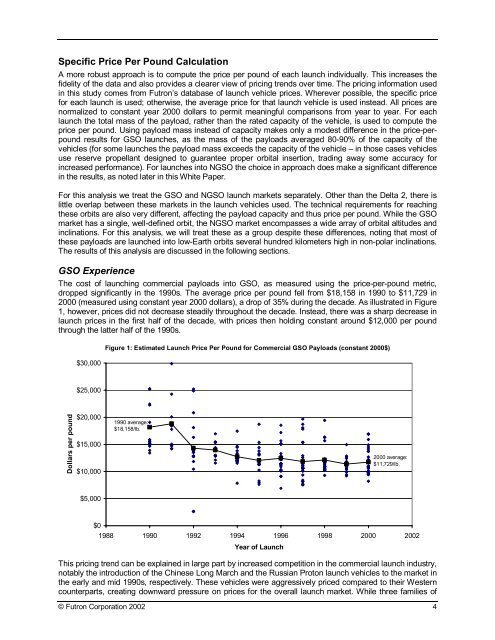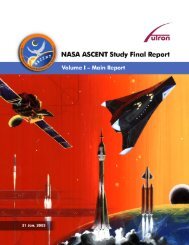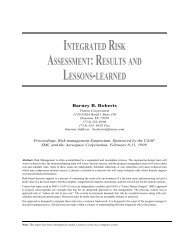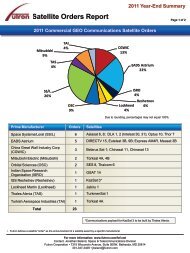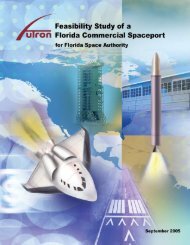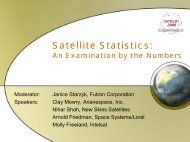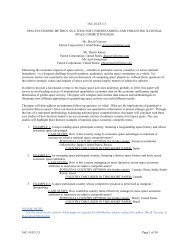Space Transportation Costs: Trends in Price Per Pound to Orbit ...
Space Transportation Costs: Trends in Price Per Pound to Orbit ...
Space Transportation Costs: Trends in Price Per Pound to Orbit ...
Create successful ePaper yourself
Turn your PDF publications into a flip-book with our unique Google optimized e-Paper software.
Specific <strong>Price</strong> <strong>Per</strong> <strong>Pound</strong> Calculation<br />
A more robust approach is <strong>to</strong> compute the price per pound of each launch <strong>in</strong>dividually. This <strong>in</strong>creases the<br />
fidelity of the data and also provides a clearer view of pric<strong>in</strong>g trends over time. The pric<strong>in</strong>g <strong>in</strong>formation used<br />
<strong>in</strong> this study comes from Futron’s database of launch vehicle prices. Wherever possible, the specific price<br />
for each launch is used; otherwise, the average price for that launch vehicle is used <strong>in</strong>stead. All prices are<br />
normalized <strong>to</strong> constant year 2000 dollars <strong>to</strong> permit mean<strong>in</strong>gful comparisons from year <strong>to</strong> year. For each<br />
launch the <strong>to</strong>tal mass of the payload, rather than the rated capacity of the vehicle, is used <strong>to</strong> compute the<br />
price per pound. Us<strong>in</strong>g payload mass <strong>in</strong>stead of capacity makes only a modest difference <strong>in</strong> the price-perpound<br />
results for GSO launches, as the mass of the payloads averaged 80-90% of the capacity of the<br />
vehicles (for some launches the payload mass exceeds the capacity of the vehicle – <strong>in</strong> those cases vehicles<br />
use reserve propellant designed <strong>to</strong> guarantee proper orbital <strong>in</strong>sertion, trad<strong>in</strong>g away some accuracy for<br />
<strong>in</strong>creased performance). For launches <strong>in</strong><strong>to</strong> NGSO the choice <strong>in</strong> approach does make a significant difference<br />
<strong>in</strong> the results, as noted later <strong>in</strong> this White Paper.<br />
For this analysis we treat the GSO and NGSO launch markets separately. Other than the Delta 2, there is<br />
little overlap between these markets <strong>in</strong> the launch vehicles used. The technical requirements for reach<strong>in</strong>g<br />
these orbits are also very different, affect<strong>in</strong>g the payload capacity and thus price per pound. While the GSO<br />
market has a s<strong>in</strong>gle, well-def<strong>in</strong>ed orbit, the NGSO market encompasses a wide array of orbital altitudes and<br />
<strong>in</strong>cl<strong>in</strong>ations. For this analysis, we will treat these as a group despite these differences, not<strong>in</strong>g that most of<br />
these payloads are launched <strong>in</strong><strong>to</strong> low-Earth orbits several hundred kilometers high <strong>in</strong> non-polar <strong>in</strong>cl<strong>in</strong>ations.<br />
The results of this analysis are discussed <strong>in</strong> the follow<strong>in</strong>g sections.<br />
GSO Experience<br />
The cost of launch<strong>in</strong>g commercial payloads <strong>in</strong><strong>to</strong> GSO, as measured us<strong>in</strong>g the price-per-pound metric,<br />
dropped significantly <strong>in</strong> the 1990s. The average price per pound fell from $18,158 <strong>in</strong> 1990 <strong>to</strong> $11,729 <strong>in</strong><br />
2000 (measured us<strong>in</strong>g constant year 2000 dollars), a drop of 35% dur<strong>in</strong>g the decade. As illustrated <strong>in</strong> Figure<br />
1, however, prices did not decrease steadily throughout the decade. Instead, there was a sharp decrease <strong>in</strong><br />
launch prices <strong>in</strong> the first half of the decade, with prices then hold<strong>in</strong>g constant around $12,000 per pound<br />
through the latter half of the 1990s.<br />
$30,000<br />
Figure 1: Estimated Launch <strong>Price</strong> <strong>Per</strong> <strong>Pound</strong> for Commercial GSO Payloads (constant 2000$)<br />
$25,000<br />
Dollars per pound<br />
$20,000<br />
$15,000<br />
$10,000<br />
1990 average:<br />
$18,158/lb.<br />
2000 average:<br />
$11,729/lb.<br />
$5,000<br />
$0<br />
1988 1990 1992 1994 1996 1998 2000 2002<br />
Year of Launch<br />
This pric<strong>in</strong>g trend can be expla<strong>in</strong>ed <strong>in</strong> large part by <strong>in</strong>creased competition <strong>in</strong> the commercial launch <strong>in</strong>dustry,<br />
notably the <strong>in</strong>troduction of the Ch<strong>in</strong>ese Long March and the Russian Pro<strong>to</strong>n launch vehicles <strong>to</strong> the market <strong>in</strong><br />
the early and mid 1990s, respectively. These vehicles were aggressively priced compared <strong>to</strong> their Western<br />
counterparts, creat<strong>in</strong>g downward pressure on prices for the overall launch market. While three families of<br />
© Futron Corporation 2002 4


